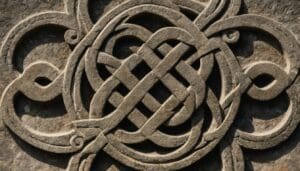Best Historical Places to Visit in Cairo
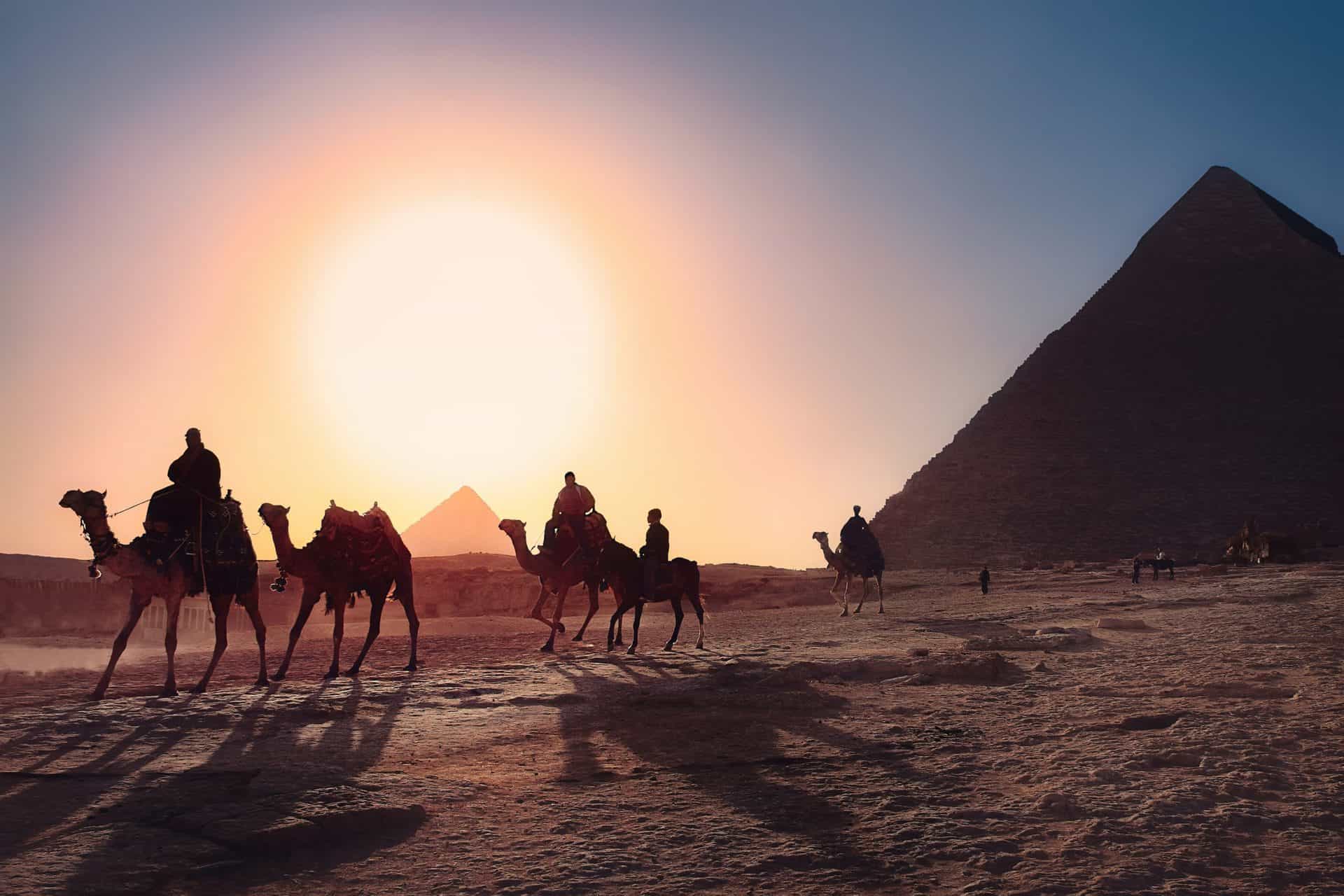
Updated On: April 16, 2024 by Ciaran Connolly
Cairo, the capital city of Egypt and home to more than 10 million people, is one of the great megacities in the world. The metropolitan megacity is the largest in whole of Africa and the Middle East.
The city has different nicknames that capture its spirit. It is “the city of a thousand minarets”, “the city that never sleeps”, and “the city of the dead”. As the nicknames suggest, Cairo is a vibrant city that’s full of life as well as history. There are many places to visit in Cairo.
Cairo is probably the first stop for anyone that visits Egypt. The city is located right on the famous Nile River and comprises many places that are worth visiting. Even though The Pyramids are what Cairo is famous for, it is not all that the city has to offer. Cairo is filled with many museums, monuments, historical edifices, and brilliant architecture. The Pharaonic, Coptic, and Islamic monuments of the city depict its diversity and inclusivity.
Located in the Middle East, Cairo’s weather is mostly hot. During the summer, daytime highs typically reach 35°C (95°F) with high humidity, due to its location near the Mediterranean Sea. Rain is rare and usually falls during winter. On the other hand, Cairo has pleasant winters. The winter days are almost always sunny which saves you from the gloomy feeling of winter. Cairo’s winters usually have a high of 20°C (68°F). So, it is better to visit Cairo during winter to avoid the hot summer weather.
Top Places to Visit in Cairo
The various places to visit in Cairo might confuse you as a visitor as you won’t know what to choose. Avoid the confusion with our list of the top places you have to visit in the vibrant capital. Use the list to arrange your Cairo itinerary the next time you are here.
The Pyramids of Giza
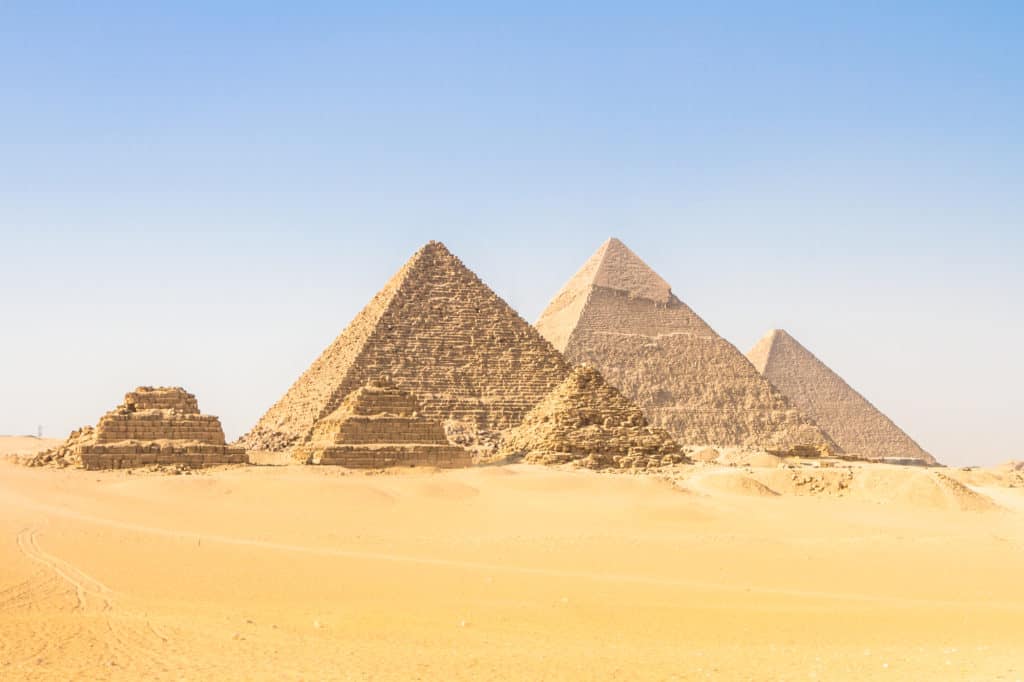
Seeing thousands of pictures of the Pyramids would never beat the real-life experience of getting close to the wonderful monuments. The Pyramids never failed to wow millions throughout the centuries. If you do not have to visit the Pyramids on your bucket list, it is surely one of your top places to visit in Cairo.
These majestic masterpieces were built almost 5,000 years ago, at the beginning of human recorded history. The three Pyramids of Giza include the Great Pyramid, the Pyramid of Khufu, and the other two Pyramids, the Pyramid of Khafre and the Pyramid of Menkaure.
The Great Pyramid is the oldest of the three main pyramids and is the site’s most famous monument. It was built around 2570 BC by the Pharaoh Khufu, hence its name and is one of the most well-known monuments in the whole world. It is believed that 100,000 men worked on the construction of the Great Pyramid for three months every year. For 3,800 years, the Great Pyramid was the tallest building in the world, until the Lincoln Cathedral was built in 1311 AD in England.
The Pyramid of Khafre is exactly 160 meters to the southwest of the Great Pyramid. It was built by Khufu’s son Khafre. Even though the Pyramid of Khafre appears to be larger than the Great Pyramid, this is not true. It just stands on a higher part of the land. The top of the Pyramid has managed to preserve the exquisitely burnished blocks of high quality that once covered the majority of it.
The Pyramid of Menkaure is the smallest of the three Pyramids. It stands at a height of 65 meters. It was built by the 4th-dynasty pharaoh Menkaure as his own tomb.
There is an entry fee of EGP 200 ($13). And, if you are a student, you get a 50% discount. So, a student ticket is for EGP 200 ($6.5). In case you’d like to get inside the Pyramids, the ticket for the Great Pyramid (the Pyramid of Khufu) is EGP 400 ($25.5) or EGP 200 ($13) for students. However, the ticket for the Pyramid of Khafre is EGP 100 ($6.5), or EGP 50 ($3.20) for students.
If you are visiting the Pyramids between October and March, you can visit from 8 am to 4 pm. These are the times at which tickets are available. However, if you are already at the location, the monument closes at 5 pm. During summer, from April to September the visiting hours are from 7 am until 7 pm.
The Egyptian Museum
The Egyptian Museum, the Museum of Egyptian Antiquities, and the Museum of Cairo, all are the different names used to call the great museum located in Tahrir Square in Cairo. The Museum is one of the most interesting places to visit in Cairo. It was originally established by French Egyptologist August Mariette on the bank of the River Nile at Boulaq in 1857. It was then moved to its current location at the distinctive powder-pink mansion in Downtown Cairo in 1897.
The museum has a collection of around 120,000 items, making it one of the largest museums in the region. It shows some of the rarest historical antiques which give it its reputation as being one of the world’s most incredible exhibition halls. With various collections dating back to prehistoric times, the artefacts and antiques shown at the museum reveal an extensive scenario of the civilization of Egypt. The museum also holds the record of having the largest collection of Pharaonic antiques in the world.
The first thing you can see after reaching the museum is different collections and artefacts from the New Kingdom, the period from 1550 to 1069 BC. These include coins, coffins, large statues, tables, and pieces of manuscripts. Unfortunately, most of the manuscripts have decayed as a result of ageing. Unlike the manuscripts, the coins have been restored and made of gold, silver, and bronze. All these interesting pieces can actually be seen as soon as you pass the security check at the museum’s entrance. Then, you can move to the next part of the museum, the first floor.
The 1st floor (second level) contains thousands of smaller items from the last two dynasties that ruled Egypt. These items include collections from the Valley of the Kings and the Tombs of Pharaohs Thutmosis-III, Thutmosis-IV, Amenophis-II and Hatshepsut. However, the most popular artefacts on the floor are those discovered in Tutankhamun’s tomb. They take up a large area of the floor.
The treasures found in the Pharaoh’s tomb include chariots, gloves, jewellery, and the famous Golden Death Mask Tutankhamun. Tutankhamun’s tomb contained four gilded shrines nested one inside the other. All four of these shrines are on display in the museum. Other famous items worth visiting in the museum are Inlaid Diadem with Vulture and Cobra Uraeus.
The museum is open for visitors daily from 9:00 am to 5:00 pm. There is an entrance fee of EGP 120 ($7.63) and an additional EGP 30 ($1.91) for a photography permit. Make sure to get that permit as there are a lot of things you’d like to keep a memory of.
Al Azhar Mosque
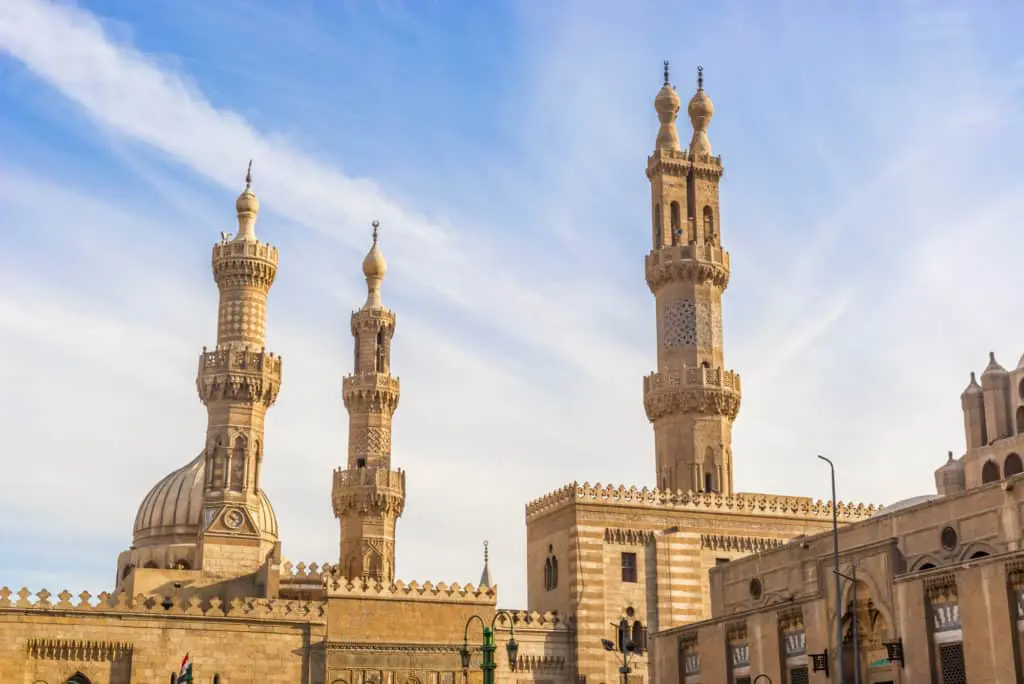
Al-Azhar Mosque was built in 970 AD by Jawhar Al-Siqilli, a ruler of the Fatimid Dynasty of Egypt. The construction of the mosque took 2 years. The name Al-Azhar means “The Splendid” and is thought to relate to Fatimah Al-Zahraa, the daughter of Prophet Muhammad, who was an admired figure in Islam. The construction of the mosque was commissioned by Caliph Al-Muizz for the then newly established capital city, Cairo. The decision of building Al-Azhar was made by the Fatimid Dynasty as an establishment of their power in the Islamic world.
Al-Azhar mosque is without a doubt the finest building of the Fatimid era’s Cairo and one of the city’s oldest mosques. Being one of the earlier mosques in Cairo is not the only sign of Al-Azhar. It was turned into the second oldest continuously run university in the world by 988 AD. Since then, Al-Azhar has been one of the top universities to study Islamic law and one of the most influential Islamic schools of higher learning.
The mosque is a living example of the architectural brilliance of the Fatimid era. It comprises five outstanding Minarets, a large prayer hall, and the famous, elegant marble courtyard. The courtyard is rectangular and is surrounded by arcades. All the arcades have keel-shaped arches in them which is a unique style of Fatimid architecture. Across the courtyard lies the main prayer hall, spanning a vast 3,000 square meters. The original prayer hall was built as a hypostyle hall, which has a roof supported by columns. The mosque in general has limited decoration, and all its existing decoration is made of stucco, which is a unique aspect of the mosque.
Al-Azhar mosque is located at the centre of downtown Cairo. Since its establishment, Al-Azhar has been a spectacular landmark of the city. The mosque has 8 enormous gates inviting its visitors to get inside and explore its stunning beauty. The main entrance of the mosque is Bab Al-Muzayinin (Gate of the Barbers). The Gate is a double-arched portal made of stone with recessed arches around the two doors. This main gate was not actually constructed until the mid-eighteenth century.
With the mosque’s location in the busy downtown area, the mosque provides a sanctuary for its visitors to stop for a moment and respite from the outer world. It is one of the city’s key markers. When you are in Cairo, make sure to pay a visit to the splendid mosque. It is without hesitation one of the most important places to visit in Cairo. There is an entry fee of around $1 per person.
The Hanging Church
The Hanging or Suspended Church, in Arabic Al-Moallaqa, is the famous name of Saint Virgin Mary’s Coptic Orthodox Church. The church is one of Egypt’s oldest churches. Its name ‘Hanging’ comes from the fact that it was built on the ruins of the Roman fortress. The first construction of the Hanging Church more probably appeared in the 3rd or 4th century as a very humble building with palm logs and stones as a fundament. The permanent structure was built later in the 690s.
This famous church was the house of the Coptic Orthodox pope’s seat from 1047 to the 13th century. Being the Coptic Patriarch’s residence for centuries, the Hanging Church witnessed important elections and religious ceremonies. It was also the place to host synods that determined when Easter should be celebrated. The church contains three sanctuaries on the eastern side, the one in the middle is dedicated to the Virgin Mary, the one to the left is named after St. George and the one to the right is named after John the Baptist. Painted baldachins are placed above the altars inside the sanctuaries.
The historical and religious importance is not all that the Hanging Church has. This most famous church in Coptic Cairo contains stunning examples of Coptic architecture. It has heavy doors adorned with ebony, ivory and marble pillars. The ceiling of the church resembles Noah’s ark with two bell towers looming above it. The church is one of the first in Egypt to be built in the style of a basilica. The porch, which dates to the 11th century, has miraculously survived centuries of shuffling feet and processions.
There are a total of 110 icons kept in the Hanging Church. The oldest of these icons is the “Coptic Mona Lisa”. This icon dates back to the 8th century AD, it represents Virgin Mary, Jesus Christ and John the Baptist. Other altar icons date back to the 18th century.
Gorgeous lotus-shaped wooden panels decorate the wall above the altar. They are placed right below images of Jesus’ disciples. The images of the disciples are painted in a distinctive Coptic style.
This distinctive church is a must-see. It is definitely one of the places to visit in Cairo. There is no entry fee to visit the church. The Hanging Church is open to visitors every day from 9:00 am to 5:00 pm. There is a Coptic Mass held from 8:00 am to 11 am every Wednesday and Friday, and from 9:00 am to 11:00 am on Sundays. Everyone is welcome to observe. While there is no dress code required, it is appreciated to wear something that goes down to at least your knees and avoid sleeveless attires.
Khan El Khalili
Khan Al Khalili is a medieval-style bazaar located at the heart of Islamic Cairo. The bazaar was built on the old burial site of the Fatimid Caliphs. While trading in the bazaar started in the 14th century, the skinny alleyways of Khan Al Khalili and its elaborately carved monumental gates were constructed in the 16th century under the last Mamluk ruler of Egypt. While some shops are located in narrow alleys, many others are arranged around small courtyards.
The shops in Khan Al Khalili have everything from soap powder to actual gold. However, the market is very famous for a number of goods. These include spices, fabric, perfumes, silver, and gold. An important thing to mention is that if you are a fan of belly dancing, this is your golden chance to get your belly dancing costume. Many merchants have booths where they sell authentic copper accessories for very affordable prices. The market is also a great place to pick the souvenirs you want to take back home with you.
The great thing about shopping at Khan Al Khalili is that even if the merchant you are dealing with does not have what you want, they will go and find for you another merchant that does. This shopping experience is a great chance for you to try out your haggling skills. Haggle, haggle, haggle then haggle some more. Do not buy anything at Khan Al Khalili without haggling! you will be surprised how much of the price you can get off just by haggling.
For your well-deserved shopping break, the area is full of spots where you can get something to eat or drink. The space is home to various old cafes, the most famous of which is El-Fishawi. This is one of the oldest cafes in Cairo, its establishment dates back to 1797. This café was also one of Naguib Mahfouz’s favourite cafes and it never closes its doors. It is open 24 hours a day, 7 days a week. You can sit down there, or at any other café in the area, and enjoy a cup of Arabic coffee that is usually brewed with spices.
Another coffeehouse that is worth a visit is El-lord where you can enjoy your drink while listening to the great songs of Umm Kulthum. As for food, you can either go into one of the traditional restaurants at Khan Al Khalili or get a small bite from one of the street vendors in the area.
If you want to get the full experience of the vibrant Cairene streets, Khan Al Khalili is definitely one of the places to visit in Cairo. Even if you do not want to buy anything, walking in the alleyways is an experience in itself. The market usually opens around 9:00 am and does not close until past midnight. Try to avoid going there on Sunday as most of the traders at the market take that day off.
The Coptic Museum
Cairo’s charm lies in its diversity. It is a city where different religions and cultures exist in beautiful harmony. This has been the reality of the cosmopolitan city for as long as history can remember. A proven example is the famous places and monuments belonging to various civilizations. An important witness to Cairo’s diverse history is the Coptic Museum. Founded in 1908, the Coptic Museum has an abundance of information about Egypt’s early Christian period. This makes it one of the most interesting places to visit in Cairo.
The story of the museum starts when Marcus Simaika Pasha, after obtaining the approval of the Patriarch, succeeded in getting the Coptic Museum built in 1908 as a part of a plot intended for the construction of a church. The museum was inaugurated for the first time in 1910. The collections of the museum were first obtained by family legacies and donations. It then became a State museum in 1931 and its collections have continued to grow since.
In 1939, the Service of Antiquities decided to transfer the totality of the Christian Antiquities exhibited in the Egyptian Museum to the Coptic Museum. Since then, all findings originating in Christian sites have automatically gone to the Coptic Museum. Nowadays, the museum occupies an area of 8,000 m2 of buildings and gardens and houses one of Egypt’s finest collections of Coptic art. The museum has around 1200 real treasures on display. However, the total collection of the museum is 16,000 pieces of art.
The museum with all its galleries is a stunning place. It shows many elaborate wood carvings, cloths, manuscripts, priestly garments, frescoes, and wooden panels as well as painted wooden ceilings and marble fountains that were collected from old Coptic palaces. There is a wealth of clothes which highlight a wide diversity of techniques and materials. They cover Biblical subjects as well as scenes from daily life. It also hosts the oldest book of psalms in the world, the Psalms of David.
When you visit the Coptic Museum, make sure to allow yourself a couple of hours to get the chance to see most if not all its treasures. The museum is open to the public daily from 9:00 am to 5:00 pm. However, the ticket office closes at 4:00 pm. There is an entrance fee of EGP 40 ($2.54).
An important note is you are not allowed to photograph anything inside the museum unless you have written approval from the Supreme Council of Antiquities. The Museum is a walking distance from the Hanging Church, you can plan both visits on the same day as both are interesting places to visit in Cairo.
Aisha Fahmy Palace
Art brought from the royals directly to you at Aisha Fahmy Palace. Princess Aisha Fahmy was the daughter of Egyptian aristocrats and army chief of King Fuad I, Ali Fahmy. The palace was designed by Italian architect Antonio Lasciac and was built in 1907. The palace is built on an area of 2,700 square meters by the Nile River. It has a charming classic European Style and Rococo interiors. The palace consists of 2 receptions, a basement and a roof.
The palace originally belonged to Aisha Fahmy’s father, Ali Fahmy. After his death, she bought her siblings’ shares in the palace to be its sole owner. She led an interesting life and lived in the palace until her death in 1962. The palace was given to the Egyptian government. It was first made into a presidential mansion. Then, in 1975, the palace was made a part of the Arts and Literature Association. In the following year, the palace became the Center of Arts.
The two-story building contains five rooms with various original textile art and European oil paintings. A room originally used for playing billiards and a billiards scoring board was turned into a living room, where the name of Fahmy’s father has been engraved in the wood. The furniture in the living room doesn’t belong to Fahmy, as the government and curators carefully chose the furniture to match the decorations in the room. The chambers of the palace are uniquely characterized by the existence of unique silk and linen canvas.
The second floor has a room dedicated to antiques and another room that was a gift to Fahmy by the Japanese embassy. The architecture of the room represents Japanese civilization. Another distinguished room is the princess’s bedroom. It was decorated with shiny gold leaves.
The artistic paintings on the windows and chandeliers in the museum have not been changed since Fahmy’s time. Only broken glass in some windows was fixed and the drawings were revived. However, the basement of the palace has been transformed into an exhibition hall.
Since 1976, the palace, now a museum, has held numerous art galleries exhibiting works of Egyptian artists as well as the art of the palace itself. Aisha Fahmy’s Palace has been recently restored by the Egyptian authority and reopened again in 2017 as an art exhibition. The place is definitely worth a visit. Even if you are not into displayed works of art, the brilliance of the palace’s interiors deserves to be checked.
The visiting hours extend from 9:00 am to 9:00 pm daily, except for Friday. There is no entry fee and photography is allowed for free as well. One note is that you will need to leave your passport with the policeman at the gate for entry. An art lover or not, Aisha Fahmy Palace should be on your list of places to visit in Cairo.
The Citadel
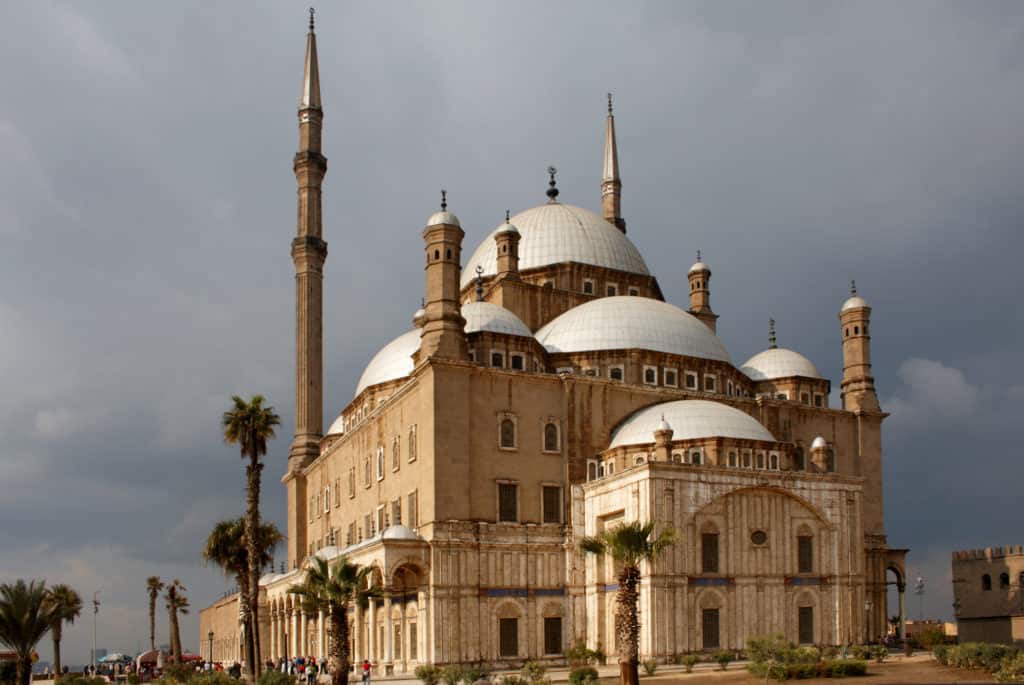
The Citadel of Salah Al-Din Al Ayyubi is an impressive defensive fortress in Islamic Cairo. The invincible citadel was built by Salah Al-Din in 1176. It has a strategic location on the hill of Muqattam which allows a panoramic view of old Cairo, giving the citadel an advanced defensive position.
Even though the construction of the citadel started during the reign of Salah Al-Din, it was not completed in his lifetime. The building was completed during the reign of Sultan Kamel Ibn Al-Adel, who decided to reside in it. This made the Citadel of Salah Al-Din Al Ayyubi the official residence of official rulers until the mid-19th century.
While the citadel is one of the most iconic monuments and places to visit in Cairo, its original layout has disappeared except for the eastern outer walls. The current layout is a collection of the legacies of different rulers that made their addition to the citadel. Here are some of the legacies and monuments you can visit while you are at the citadel:
1. Mohammed Ali Mosque
Mohammed Ali Pasha, an Egyptian ruler under the Ottoman Empire, built this mosque. Pasha took the citadel as a governing centre. He built a mosque in 1830 to carry his name and commemorate his memory.
2. Al Jawhara Palace Museum
This palace was also commissioned by Mohamed Ali Pasha. This palace was designed by artists and architects from different countries, making it an aesthetic masterpiece. The palace nowadays is a museum that houses unique antiques, such as a 1000 kg chandelier, in the audience hall of the palace.
3. Carriage Museum
Opened in 1983, the national museum of carriages has a stunning collection of royal carriages. The carriages displayed at the museum date back to Khedive Ismail’s reign until king Farouk’s. The museum was renovated in 2013 and is located right in front of Mohamed Ali mosque.
4. Military Museum
This museum was originally placed at the Ministry of War in downtown Cairo. It has been recently renovated and relocated to the citadel. It displays many objects, including the weapons used in war events of the Suez war, the Arab-Israel war and even some pharaonic military items.
Other edifices at the citadel include the El Nasser Mohammed mosque and the Sulaiman pasha mosque. The citadel comprises a number of gates that are worth checking. The site is an important landmark of Islamic Cairo, it was declared a UNESCO World Heritage Site in 1976.
You can visit this immune citadel any day you want from 9:00 am to 5:00 pm. There is an entry fee of EGP 180 ($11.45). The citadel is huge, so plan to be there for at least 4 hours to be able to enjoy most of what it offers. Also, make sure to climb to the roof of the citadel during sunset to get a dazzling view of Cairo and maybe some amazing pictures.
These are some of the historical places to visit in the vibrant city of Cairo. The city, as its Nile, is overflowing but with sights. Each of the monuments found in the city tells a story about the past events and different empires that shaped the city we see today! Allow yourself a couple of days to get to visit these historical sites and know more about the wonders of this city.
Discover other places around the world on Connolly Cove!


